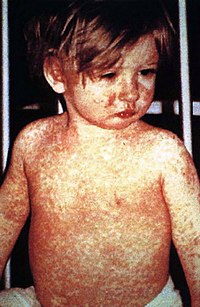
Photo from wikipedia
To the Editor: A 63-year-old Chinese woman was presented to West China Hospital complaining of dry eyes and mouth for 40 years and repeated epistaxis for 2 years. She was… Click to show full abstract
To the Editor: A 63-year-old Chinese woman was presented to West China Hospital complaining of dry eyes and mouth for 40 years and repeated epistaxis for 2 years. She was diagnosed with iron deficiency anemia (IDA) 9 years ago, and primary Sjögren’s syndrome (pSS) and primary biliary cirrhosis (PBC) 3 years ago. In the past 3 years, she was diagnosed and treated in West China Hospital for severe IDA. Repeated red blood cell suspension and iron sucrose supplementation showed no effect. She received gastroscopy 2 years ago and telangiectasia in the antrum was found. Thus, two argon plasma coagulations (APCs) were given. She had no abnormal family history. Physical examinations on admission showed tongue telangiectasia and dry eyes and mouth [Figure 1A]. Dental caries could be seen in the mouth. The skin and palpebral conjunctiva were pale. Complete blood counts showed microcytic hypochromic anemia. The increase of alkaline phosphatase, soluble transferrin receptor and total iron binding capacity were detected. Meanwhile, the decrease of serum iron, transferrin saturation and ferritin were noticed. And fecal occult blood was positive. Antinuclear antibody titer was 1:1000. Anti-SS-related antigen A (SSA) antibody and antimitochondrial type 2 antibody (AMA-M2) were positive. Schirmer test showed 3 mm and 4 mm per 5 min in the left and right eye respectively. Urine routine, glucose-6phosphate dehydrogenase, Coombs test and erythrocyte incubation osmotic fragility test were normal. Abdominal color Doppler ultrasound revealed cirrhosis, splenomegaly, ascites, abnormal hepatic veins and extrahepatic portal vein thickening. While, biliary color Doppler ultrasound showed no biliary tract stenosis. Bone marrow aspiration and biopsy suggested that erythroid hyperplasia was active, while iron stain disappeared. Therefore, she accepted gastrointestinal endoscopy and double-balloon enteroscopy after receiving red blood cell suspension and sucrose iron, which showed multiple telangiectasia of the antrum, jejunal, and colorectal [Figure 1B]. Thus, the
Journal Title: Chinese Medical Journal
Year Published: 2019
Link to full text (if available)
Share on Social Media: Sign Up to like & get
recommendations!